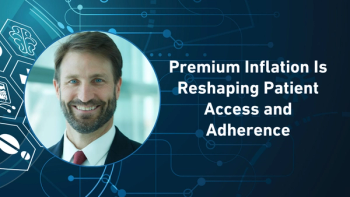
- Pharmaceutical Commerce - March/April 2014
A conversation with Bill Hook and John Menna, UPS Healthcare Logistics
UPS began making a concerted effort in healthcare logistics at the turn of this century, with the acquisition of a company called Livingston Healthcare Services, Inc. Since then, it has built up a global network of facilities and resources dedicated to healthcare products.
Pharmaceutical Commerce
sat down with Bill Hook, VP, Global Strategy — Healthcare Logistics, who is now taking on a role as senior advisor to the business unit, and John Menna, the new VP, Global Strategy – Healthcare Logistics, incoming leader for the group, to discuss the place of logistics in today’s life sciences industry. Here’s what they had to say.
1. UPS has probably been delivering packages of medicine since its founding in 1907. Take us through the more recent years as UPS Healthcare Logistics has come together, and the extent of its network today.
BILL HOOK: For more than a century, UPS has rooted its values in precision, on-time performance, and tracking and visibility—this legacy aligns very well with the demands of the healthcare industry and enables UPS to meet the exacting requirements of healthcare clients. The healthcare industry is a strategic fit for UPS, as we are an engineering-based company with extremely high quality standards, and precise delivery and measurement processes.
UPS made its first strong push into the healthcare industry in 2000 with the acquisition of Livingston Healthcare Services. Since then, we have made a number of strategic investments in technology and new capabilities to grow our healthcare presence. This is augmented by acquisitions and expansions to our network, especially in the last three years. In 2011, we acquired Italian pharmaceutical logistics company Pieffe, which grew our presence in Europe and increased our temperature-sensitive offerings. In 2013, we acquired Hungarian healthcare logistics company CEMELOG, and just last month, we acquired Polar Speed in the UK, further strengthening our European healthcare network. further strengthening our European healthcare network.
We have also invested heavily in the expansion of our global healthcare-compliant distribution network. This network of multi-client facilities enables clients to avoid the expense of building their own facilities and to scale up or down with the space they occupy in our facilities, according to their own product roadmaps.
JOHN MENNA: Our team of nearly 5,000 employees, including nearly 2,000 trained on temperature-sensitive services, executes our high standard of service within the guidelines of the more than 1,000 regulatory healthcare licenses held by UPS worldwide; these licenses differ by geography and can be specific to products such as narcotics and specialty medical devices. In the past two years, we opened three new facilities across APAC and added six expanded or new facilities in North America. Today, we have 45 fully compliant healthcare distribution facilities globally, totaling more than 6.4 million square feet of healthcare-dedicated space, in strategic locations throughout our worldwide network. We are working with some of the world’s largest biopharma and medical device companies as well as with smaller and mid-size healthcare companies around the globe.
In addition to increasing our global footprint, we have launched specialized services for the industry, such as temperature-sensitive product protection and monitoring services, risk mitigation products, packaging solutions and order-to-cash logistics services. The combination of our services, expertise, facilities and an integrated IT platform allows us to offer a broad array of solutions to our customers.
Looking ahead, healthcare will remain a top priority and area of investment for UPS. The healthcare industry is now approaching a trillion dollars in sales worldwide. As the industry grows, so does the need for specialized logistics solutions. We will continue investing in our global healthcare network to meet the evolving needs of our customers.
2. In terms of overall activity (volume, employment, revenue… whatever is relevant), how much of UPS Healthcare Logistics is air freight? How much is ground? And, how much is warehousing?
JOHN: While we don’t break out our revenue based on specific business units, I can tell you about our network’s size and productivity. On average, we pick, pack and ship 64,000 healthcare industry order lines per workday around the world. UPS ships nearly 90,000 metric tons of air freight for the healthcare industry, along with ocean freight. Our solutions help companies protect against product loss or temperature excursions. We are moving biologics, pharma and medical devices from major manufacturing centers globally to every continent.
The UPS Proactive Response service, which enables the highest level of service reliability through technology and a response team, monitors over 13 million packages a year, and we manage more than 6,500 temperature-sensitive shipments from nearly 30 countries of origins and to more than 110 country destinations. Our forward stocking locations (FSL) network makes up the largest in the world, with more than 900 strategic locations.
3. UPS, like a handful of other international freight and parcel companies, makes a point of having an integrated network—a UPS plane delivering to a UPS warehouse delivering to a UPS truck. In the healthcare logistics arena, how important is this integration? What do shippers gain, or lose, by using an integrated network?
JOHN: Our survey of the industry, UPS Pain in the (Supply) Chain, has revealed that maintaining product integrity and product visibility is of the utmost importance to healthcare product manufacturers. The UPS single, integrated network of global facilities, region-specific regulatory expertise, temperature-sensitive transportation, risk-management services, multi-modal transportation and an IT platform for tracking, provide piece of mind, cost efficiency, security and service excellence.
On the flip side, when healthcare companies do not have access to an integrated network, they may lose cost efficiencies and have visibility disconnects from using multiple providers worldwide. Potential slowdowns in customer service and potential security risks may also add burdens to companies by having to manage and work with multiple partners on a daily basis.
4. UPS has made a substantial number of investments and acquisitions around the world, but many healthcare markets are local or regional. Besides the obvious (shipping from Country A to Country B), how does a geographically-dispersed network like UPS’s provide advantages to shippers? What are the advantages or disadvantages for using UPS for local or regional deliveries, as opposed to local or regional carriers?
BILL: We touched on this in the last response, but there are a number of advantages of using a global logistics provider for local and regional shipments, especially as it relates to standardizing compliance and a company’s overall supply chain network.
UPS has facilities, regulatory expertise and capabilities in strategic markets around the world, allowing us to have specialized knowledge about each market and region. By choosing a global, integrated logistics provider, customers will gain value from improved control and visibility, quick response, assurance of compliance and simplified administration, no matter the region.
Our acquisitions have provided additional local knowledge from regions where having this knowledge is of critical importance and further deepened our understanding of the industry, which in turn increases our value to customers. Our European acquisition of CEMELOG is a perfect example, as we have gained knowledge around issues within central Europe. It truly is an outstanding team to the extent that we have taken these team members and given them broader opportunities across Europe.
In addition, because of the complexity and growth of the healthcare industry, healthcare companies are driving innovation. As a result, the global platform we are building allows our customers broader collaboration in terms of bringing in and sharing best practices.
5. The trend in the biopharma and medical device industries today is toward personalized care—specialty pharmaceuticals and delivery of healthcare products to the clinic or home (as opposed to pharmacies or big hospitals). How is UPS Healthcare Logistics adjusting to this? Are “specialty products” better off with “specialty logistics?” What is the status of direct distribution for pharmaceutical companies?
BILL: Over the past few years, we have certainly seen a shift in healthcare companies’ distribution channels and plans. And, as we saw in the most recent UPS Pain in the (Supply) Chain survey, 70% of healthcare logistics executives plan to increase their use of new distribution channels and models over the next five years to increase efficiencies and enhance competitiveness.
UPS is the leading business-to-consumer (B2C) package delivery company in the US and we deliver packages to homes on behalf of our healthcare clients. We are seeing accelerated growth in specialty products, whether it is pharmaceuticals or medical devices. Because we are that last-mile delivery network, we have a number of very specialized services for healthcare that enhance our capabilities and we will continue to build on these. Our solutions allow our clients to extend the branding experience to patients in their homes and elsewhere.
JOHN: The in-home delivery of healthcare services has grown to a $66-billion industry globally with more than a quarter of a million participating businesses. With the upcoming shift toward a more patient-centric healthcare model, UPS brings to the industry unique technologies and visibility for customers, patients and providers.
Our unparalleled model is centered on tracking and visibility from the consumer side. We have a suite of capabilities for providers and clients shipping to patients through our enriched WorldShip® applications. Shippers receive package status alerts which are complemented by messages to patients containing manufacturing information, alerts to drivers and convenient delivery options, such as UPS My Choice in the US and Kiala in Europe, which offer alternative delivery location choices.
As the direct-to-consumer (D2C) homecare channel evolves, we will continue to bring unique and tailored capabilities to ensure high-quality, timely delivery to end-patients.
6. UPS literature says that an average pharma product’s supply chain costs 9.3% of sales, while a best-in-class chain costs 4.2% of sales. What are the key differences? What should pharma companies be looking at to reduce supply chain costs?
BILL: Our whole strategy is about driving value, as mentioned before. We sit down with our customers, and hold whiteboard sessions from which we develop and leverage great ideas. As a result, we’ve seen, on average, 7—15% savings, while also mapping their existing supply chain and identifying opportunities for further enhancements. Each customer situation is different, but as an example, we recently worked with a healthcare company to optimize transportation costs that resulted in 15% savings. Oftentimes, we also partner with companies to optimize networks, which can result in an average of 8–20% savings.
At UPS, we work with our customers to ensure that their supply chains are as efficient as possible, while still prioritizing top business goals. The healthcare industry’s supply chain is more complex and sophisticated than many other industries. For example, an increasing number of healthcare products require temperature-sensitive services and monitoring, high levels of security protection and, oftentimes, premium transportation services. As a result, the supply chain costs are higher than a company shipping inexpensive books or clothes, but the cost for best-in-class services is significantly lower than losing an entire shipment due to a temperature excursion or insecure supply chain, which can result in the loss of millions of dollars, important product and time. UPS also prides itself on its robust team that makes up our customs brokerage group. By helping companies ensure regulatory compliance and avoid fines, we can save healthcare companies from potentially sizeable costs.
In the most recent UPS Pain in the (Supply) Chain survey, we were curious about what companies who were managing costs successfully were doing to achieve cost efficiency in their supply chains. Our findings showed that 56% of those successfully managing costs are doing so through logistics and distribution partnerships, 53% are investing in IT solutions such as barcoding and serialization, and 50% completed supply chain optimization analyses. We recommend that companies looking to reduce costs pursue these successful strategies; oftentimes 3PLs can work with companies to help identify additional areas for cost reduction and efficiency.
7. UPS has set an industry benchmark with its annual Pain in the (Supply) Chain survey. In your view, what are the most significant changes in biopharma industry thinking about their supply chains? And, what will healthcare-products supply chains look like in the future?
JOHN: Since we began the survey in 2008, the healthcare industry has undergone significant changes, resulting in changing supply chain strategies as companies evolve and expand. One of the most significant changes from this year was that for the first time since the survey’s inception, concerns about product security surpassed those around cost management. This is likely connected to the growing number of specialized healthcare products and growth in emerging markets.
This is an exciting and challenging time for the healthcare industry, and I am most excited about the impact of logistics on the growth of healthcare companies and the affordability of healthcare moving forward.
Healthcare companies will certainly change in the coming years. Technology advancements will bring a dramatic acceleration in the ability to serve patients in developing and emerging markets as well as here at home and in other mature markets. It will also drive growth in new channels, allowing healthcare companies to distinguish themselves with their customers, while providing stronger control and product integrity in the supply chain. We are seeing that today in the harmonization of serialization in product tracking, as an example. The industry will need to be more efficient in lowering costs and, as a result, we will see more creative solutions being introduced.
In short, technology will continue to transform the industry, giving us access to the home or remote village in Africa, increase affordability of healthcare and increase the safety of products. I believe we are at a great time in healthcare, despite the tremendous challenges, and know that the supply chain will play a central role moving forward.
8. How do you feel personally about the work you do? What keeps you up late at night?
JOHN: Bill and his UPS team have built a very solid foundation of global logistics solutions to serve the healthcare industry. UPS now has an admirable list of healthcare clients and a vision for the future of healthcare logistics. My role is to be a responsible steward of the business and help guide the evolution of industry-leading, compliant solutions engineered to meet the unique and demanding needs of life sciences companies. UPS will continue to be a thought leader and innovator in global healthcare logistics.
When I am not working on UPS healthcare and temperature-sensitive strategies, I can be found in a temperature-controlled ice hockey rink where I volunteer as a coach.
BILL: In one’s role, or position, you want your accomplishments to have a meaningful, positive impact on customers, employees and financial results. In healthcare, this is extended to people’s health and well-being. Throughout my career I have had the need to push the boundaries. Although UPS can have the complexity that comes with a big company, it has the environment and resources that enables us to accomplish our vision of creating a vibrant, global healthcare business that is indeed positively impacting those key stakeholders I just mentioned. In the past few days I received, from a friend, a picture of a sign with a UPS slogan written in Arabic from a new (facility) location in the Middle East. I had to smile with satisfaction at the translation: “It’s a Patient, not a Package,” which is the mindset we try to instill around the world. Having our people embrace the importance of our role in the healthcare supply chain is very satisfying. I have no doubt that UPS is on track for continued growth and impact in healthcare into the future.
Articles in this issue
almost 12 years ago
The pharma rep profession will be immortalalmost 12 years ago
Six factors driving new specialty pharmaciesalmost 12 years ago
Common misconceptions about the orphan drug designationalmost 12 years ago
AbbVie enters Asian manufacturing with a $320-million site in Singaporealmost 12 years ago
So you are 'in the cloud;' now what?almost 12 years ago
Network effect of industry-crowdsourced physician dataalmost 12 years ago
Make your CRM vendor a true partner to your sales teamalmost 12 years ago
New adverse-events reporting service speeds results to payersalmost 12 years ago
Acquisitions realign UK logistics services, cold chain packagingalmost 12 years ago
After a relatively flat year, 2014 could be big for pharma M&ANewsletter
Stay ahead in the life sciences industry with Pharmaceutical Commerce, the latest news, trends, and strategies in drug distribution, commercialization, and market access.




